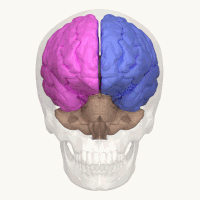
Photo from wikipedia
Perinatal stroke causes lifelong disability, particularly hemiparetic cerebral palsy. Arterial ischemic strokes (AIS) are large, cortical, and subcortical injuries acquired near birth due to acute occlusion of the middle cerebral… Click to show full abstract
Perinatal stroke causes lifelong disability, particularly hemiparetic cerebral palsy. Arterial ischemic strokes (AIS) are large, cortical, and subcortical injuries acquired near birth due to acute occlusion of the middle cerebral artery. Periventricular venous infarctions (PVI) are smaller, subcortical strokes acquired prior to 34 weeks gestation involving injury to the periventricular white matter. Both stroke types can damage motor pathways, thus, we investigated resulting alterations in functional motor networks and probed function. We measured blood oxygen level dependent (BOLD) fluctuations at rest in 38 participants [10 arterial patients (age = 14.7 ± 4.1 years), 10 venous patients (age = 13.5 ± 3.7 years), and 18 typically developing controls (TDCs) (age = 15.3 ± 5.1 years)] and explored strength and laterality of functional connectivity in the motor network. Inclusion criteria included MRI‐confirmed, unilateral perinatal stroke, symptomatic hemiparetic cerebral palsy, and 6–19 years old at time of imaging. Seed‐based functional connectivity analyses measured temporal correlations in BOLD response over the whole brain using primary motor cortices as seeds. Laterality indices based on mean z‐scores in lesioned and nonlesioned hemispheres explored laterality. In AIS patients, significant differences in both strength and laterality of motor network connections were observed compared with TDCs. In PVI patients, motor networks largely resembled those of healthy controls, albeit slightly weaker and asymmetric, despite subcortical damage and hemiparesis. Functional connectivity strengths were not related to motor outcome scores for either stroke group. This study serves as a foundation to better understand how resting‐state fMRI can assess motor functional connectivity and potentially be applied to explore mechanisms of interventional therapies after perinatal stroke.
Journal Title: Human Brain Mapping
Year Published: 2019
Link to full text (if available)
Share on Social Media: Sign Up to like & get
recommendations!